A) the development of a black market in chocolate bars.
B) the allocation of chocolate bars by sellers preference.
C) the allocation of chocolate bars on a first-come,first-serve basis.
D) the stockpiling of unsold inventories of chocolate bars.
E) the rationing of chocolate bars.
Correct Answer

verified
Correct Answer
verified
Multiple Choice
Consider a competitive labour market.The likely consequence of a binding minimum wage in this labour market is
A) a labour shortage.
B) a lower wage for all individuals.
C) a higher wage for all individuals.
D) excess demand for workers.
E) unemployment.
Correct Answer

verified
Correct Answer
verified
Multiple Choice
If the government fixes the price of good X above its free-market equilibrium level,we should expect
A) a surplus of good X to occur.
B) a shortage of good X to occur.
C) an excess demand for good X.
D) a black market to arise for good X.
E) a new free-market equilibrium price to be established.
Correct Answer

verified
Correct Answer
verified
Multiple Choice
In competitive markets,binding price floors and binding price ceilings lead to
A) a reduction in deadweight loss.
B) fairer prices for consumers and producers,and therefore are better for society as a whole.
C) an overall increase in economic surplus,and therefore to market efficiency.
D) a maximization of economic surplus.
E) an overall reduction in economic surplus,and therefore to market inefficiency.
Correct Answer

verified
Correct Answer
verified
Multiple Choice
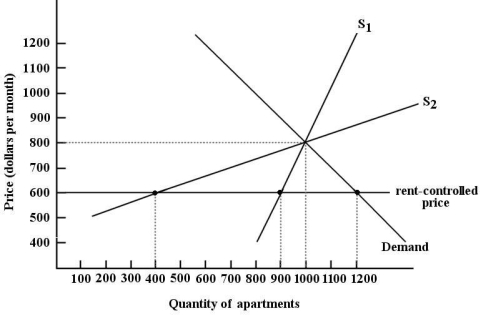 FIGURE 5-4
-Refer to Figure 5-4.The difference between supply curve S1 and supply curve S2 in this market for apartments is that
FIGURE 5-4
-Refer to Figure 5-4.The difference between supply curve S1 and supply curve S2 in this market for apartments is that
A) S1 is not affected by a government controlled rental price.
B) S2 is not affected by a government controlled rental price.
C) S1 is more elastic than S2.
D) S1 is a short-run supply curve and S2 is a long-run supply curve.
E) S1 is a long-run supply curve and S2 is a short-run supply curve.
Correct Answer

verified
Correct Answer
verified
Multiple Choice
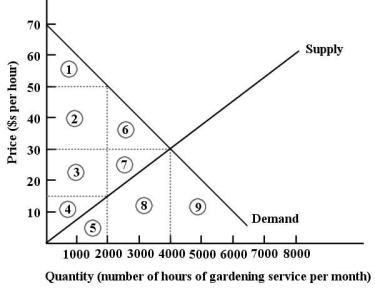 FIGURE 5-5
-Refer to Figure 5-5.Suppose this market for gardening services is in a free-market equilibrium.If the government then imposes a price floor of $50 per hour for gardening services,the result would be
FIGURE 5-5
-Refer to Figure 5-5.Suppose this market for gardening services is in a free-market equilibrium.If the government then imposes a price floor of $50 per hour for gardening services,the result would be
A) a loss of economic surplus of the areas 6 and 7.
B) a loss of economic surplus of the areas 2 and 6.
C) a loss of economic surplus of the area 1.
D) a loss of economic surplus of the areas 2,3,4,6,and 7.
E) a loss of economic surplus of the areas 1,2,3,and 4.
Correct Answer

verified
Correct Answer
verified
Multiple Choice
At any disequilibrium price,whether government controlled or not,the quantity actually exchanged is determined by
A) the elasticity of supply.
B) the elasticity of demand.
C) government decree.
D) the lesser of quantity demanded and quantity supplied.
E) the greater of quantity demanded and quantity supplied.
Correct Answer

verified
Correct Answer
verified
Multiple Choice
Assume that the long-run supply of housing is highly elastic.The imposition of binding rent controls will lead to
A) a reduction in the housing shortage over time.
B) a worsening of the housing shortage over time.
C) no significant change in the housing shortage over time.
D) only a temporary housing shortage.
E) the price of rental housing to revert back to its free-market equilibrium level.
Correct Answer

verified
B
Correct Answer
verified
Multiple Choice
 FIGURE 5-5
-Refer to Figure 5-5.At the market-clearing price and quantity of $30 per hour and 4000 hours of gardening services,we can say that
FIGURE 5-5
-Refer to Figure 5-5.At the market-clearing price and quantity of $30 per hour and 4000 hours of gardening services,we can say that
A) economic surplus could be increased at a lower price because there would be more value to consumers.
B) economic surplus could be increased at a higher price because firms would generate more revenue.
C) economic surplus is maximized and the market is efficient.
D) the market is inefficient because there are some consumers who are not purchasing at this price.
E) the market is efficient because the government has imposed a market-clearing price and quantity.
Correct Answer

verified
Correct Answer
verified
Multiple Choice
If the equilibrium price for some product is $1000,a price ceiling of $1200 will result in
A) the same general effects as a price floor of $1200.
B) the same general effects as an administered price of $1200.
C) the same general effects as a price ceiling of $600.
D) massive surpluses of the good.
E) no effects because the price ceiling is not binding at that price.
Correct Answer

verified
Correct Answer
verified
Multiple Choice
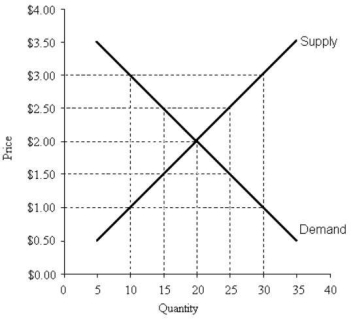 FIGURE 5-2
-Refer to Figure 5-2.A price floor set at $2.50 will result in
FIGURE 5-2
-Refer to Figure 5-2.A price floor set at $2.50 will result in
A) a shortage of 5 units.
B) a shortage of 10 units.
C) a surplus of 10 units.
D) a surplus of 5 units.
E) no change to the market outcomes.
Correct Answer

verified
Correct Answer
verified
Multiple Choice
Each point on a supply curve shows the ________ acceptable price to firms for selling that unit; this price reflects ________ to firms from producing that unit.
A) minimum; the equilibrium price
B) maximum; the additional value
C) minimum; the additional value
D) maximum; the additional cost
E) minimum; the additional cost
Correct Answer

verified
E
Correct Answer
verified
Multiple Choice
Suppose the government establishes a ceiling on the price of rental accommodation that is lower than the free-market equilibrium price.In this case,
A) construction of new rental units will be encouraged.
B) the rental housing market will be unaffected.
C) those people who obtain rental units at the ceiling price will benefit.
D) a surplus of current rental units will develop.
E) the current stock of rental housing will be better maintained as there is a shortage of housing.
Correct Answer

verified
Correct Answer
verified
Multiple Choice
Suppose the government sets a particular price in the market for gold,which results in an excess supply.In this situation,
A) the market is in equilibrium.
B) the market is in disequilibrium.
C) there are unsuccessful buyers.
D) the gold market has not reached the point of saturation.
E) no gold will be exchanged.
Correct Answer

verified
Correct Answer
verified
Multiple Choice
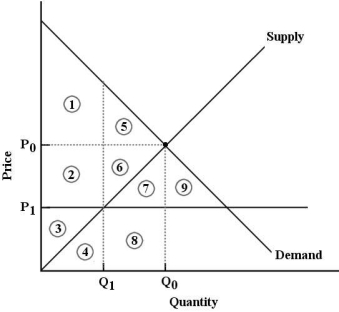 FIGURE 5-6
-Refer to Figure 5-6.The market for good X is in equilibrium at P0 and Q0.Economic surplus is represented by
FIGURE 5-6
-Refer to Figure 5-6.The market for good X is in equilibrium at P0 and Q0.Economic surplus is represented by
A) areas 1 and 5.
B) areas 2,3,4,6,7,8.
C) areas 1,2,3,5,6.
D) areas 1,2,3,4,5,6,7,8.
E) areas 2,3,4,6,7,8,9.
Correct Answer

verified
Correct Answer
verified
Multiple Choice
Which of the following is true of price ceilings?
A) Firms must charge the price established as a price ceiling.
B) If the ceiling price is set above the free-market equilibrium price it will have no effect on the market.
C) A ceiling price below the free-market equilibrium price is not binding.
D) With a non-binding ceiling price an excess demand for the product will develop.
E) With a binding ceiling price a surplus of the commodity will develop.
Correct Answer

verified
B
Correct Answer
verified
Multiple Choice
Consider the Canadian market for barley.Suppose a marketing board sets a production quota which is below the equilibrium quantity.The quota will cause the price of barley to ________ and the total revenue earned by Canadian barley farmers to ________.
A) rise; rise if demand is inelastic
B) rise; rise if demand is elastic
C) fall; fall if demand is inelastic
D) fall; fall if demand is elastic
E) remain unchanged; remain unchanged
Correct Answer

verified
Correct Answer
verified
Multiple Choice
The shortages associated with a binding price ceiling will be the smallest when
A) both supply and demand are highly elastic.
B) both supply and demand are highly inelastic.
C) supply is highly elastic and demand is highly inelastic.
D) supply is highly inelastic and demand is highly elastic.
E) none of the above-the size of the shortage has nothing to do with demand and supply elasticities.
Correct Answer

verified
Correct Answer
verified
Multiple Choice
If the free-market equilibrium price for some product is $25,then a legal price ceiling set at $15 will bring about
A) the same general effects as a price ceiling of $25.
B) the same general effects as an equilibrium price of $15.
C) no change in the market outcomes.
D) a surplus of the good.
E) a shortage of the good.
Correct Answer

verified
Correct Answer
verified
Multiple Choice
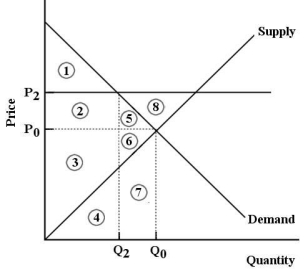 FIGURE 5-7
-Refer to Figure 5-7.The market for good X is in equilibrium at P0 and Q0.Now suppose the government imposes a ________ at P2.One result would be ________.
FIGURE 5-7
-Refer to Figure 5-7.The market for good X is in equilibrium at P0 and Q0.Now suppose the government imposes a ________ at P2.One result would be ________.
A) price floor; an increase in economic surplus represented by area 1
B) price floor; a deadweight loss represented by areas 5 and 6
C) price ceiling; an increase in economic surplus represented by areas 2 and 5
D) price floor; a deadweight loss represented by area 8
E) price ceiling; a deadweight loss represented by areas 5 and 6
Correct Answer

verified
Correct Answer
verified
Showing 1 - 20 of 125
Related Exams